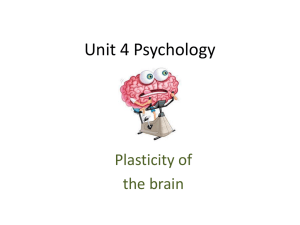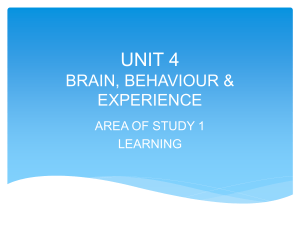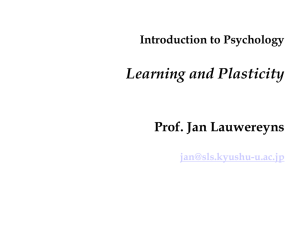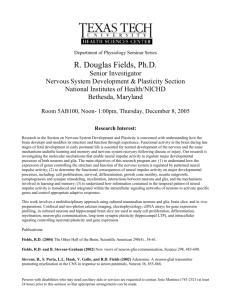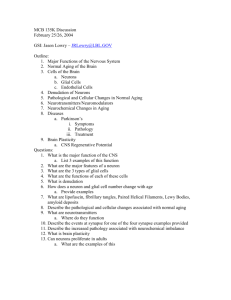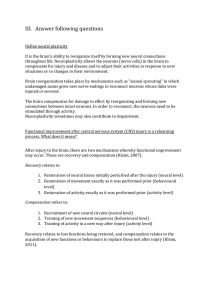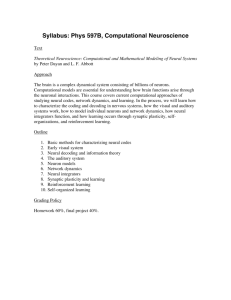File
advertisement
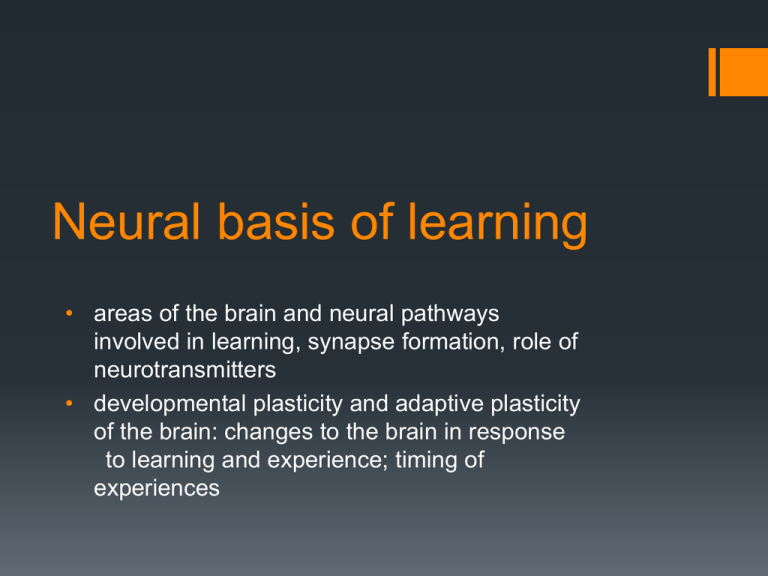
Neural basis of learning • areas of the brain and neural pathways involved in learning, synapse formation, role of neurotransmitters • developmental plasticity and adaptive plasticity of the brain: changes to the brain in response to learning and experience; timing of experiences Neural basis of learning Neurons are soft, flexible living cells They can change their size, shape, function and connections with other neurons throughout our lifespan Influenced by interaction between biological influences and experiences in everyday life Synapse – includes the synaptic gap, presynaptic neuron and postsynaptic neuron Neurons and learning When learning occurs changes take place at the synapse Learning involves establishing and strengthening of neural connections at the synapse Groups of neurons form pathways (networks) for the learned information Some pathways overlap, means more than one pathway may be involved in different learning More a pathway is used, stronger the neural connections and the more efficient the transfer of information. The less a pathway is used, it can weaken and become less efficient in transmitting information Neurons and learning Neurotransmitters can excite a postsynaptic neuron (making more likely to fire) or inhibit (making it less likely to fire) Neurotransmitters are chemical substances that carry information between neurons Glutamate: strengthens connections at the synapse during learning Dopamine: communicates activities which may be rewarding though ‘pleasure’ experiences Acetylcholine (Ach) present in some learning but role is unclear Neurons and learning Synaptic changes caused by learning are believed to have long-term potentiation LTP The long-lasting strengthening of synaptic connections resulting in the enhanced functioning of neurons along a neural pathway whenever activated LTP is a crucial mechanism of learning, learning may not be possible without it LTP and learning Morris et al. (1982) – Rats and a water maze Group 1 Damaged cerebral cortex in Role of the hippocampus inthe spatial upperlearning frontal lobe Group 2 Damaged hippocampus Group 3 ‘normal’ rat, no damage http://www.youtube.com/watch?v=_uco9kTr_jI http://www.youtube.com/watch?v=LrCzSIbvSN4 Plasticity – the ability for the brain to change through experience Plasticity – ability of the brain’s neural structure or function to be changed by experience throughout the lifespan Flexible Lifelong Plasticity (learning experiences throughout our life) Genes are the ‘architect’, our experience guides, sustains and maintains us. Developing brain is more plastic (flexible) than the adult brain Brain can be altered by learning and experience Plasticity experiments Evidence the brain is altered by learning and experience Rosenzweig et. al. (1960s) Lab rats 3 conditions (80 days) 1 – standard lab cage 2 – ‘impoverished’ (deprived environment) 3 – ‘enriched’ environment Findings of enrichment and impoverishment studies ‘enriched’ rats had a thicker and heavier cerebral cortex Bushier dendrites Existing synapses were bigger New synapses were formed Findings of impoverishment and enrichment studies on people University students 40% more synaptic connections than people who do not complete high school Enrichment activities in old age reduces the risk of cognitive decline in old age Developmental plasticity (maturation) Brain’s natural ability to form new connections in order to process sensory information from the environment. It is the neural changes which occur to the brain due to experience during maturation (growth and development). It has a genetic base but is influenced by experience Child’s brain has greater plasticity than an adults brain Developmental plasticity decreases with age Developmental Plasticity (maturation) Synaptogenesis – process of forming new synapses Synaptic pruning – process of eliminating synaptic connections occurs in different areas of the brain at different times. visual cortex finished by age 10 frontal lobe age 14 Adults have 40% less than a 3yr old Experience determines which synapses will be pruned or strengthened. Developmental Plasticity (maturation) Timing of the brain Sensitive period period of time when we are more sensitive to certain environmental cues (language acquisition, eye – connect to visual cortex). Sensitive periods suggests there are times when some synaptic connections are more easily made and neural pathways are more easily formed – but need exposure to the environment Experience-expectant process – brain is genetically primed, or getting ready, for experiences that are expected at a particular time (during a sensitive period) Adaptive Plasticity (Think of it as the brain trying to adjust to compensate, the brain is trying to adapt) Adaptive Plasticity is the brain’s ability to form new connections in order to recover or compensate for lost function and or to maximise remaining functions in the event of brain injury Occurs to a greater extend in infancy and early childhood Adaptive Plasticity Neural rerouting Undamaged neuron lost connection with an active neuron, may seek a new active neuron and connect with it instead. Sprouting growth of new bushier nerve fibres with more branches to make new connections To form new connections, need to be stimulated through activity. Examples of people where function of one hemisphere is taken over by the other hemisphere
